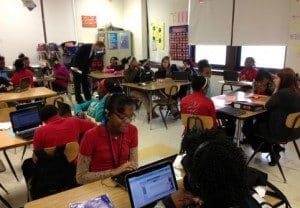EAA Pioneers Flexible Blended Learning Spaces
CompetencyWorks Blog
Originally posted Aug. 3, 2014 at Getting Smart.

Five Detroit schools utilize flexible learning spaces to accelerate student learning. These innovative environments reconsider four components of teaching and learning:
- Space & time: creative ways of using space, furniture, scheduling and location to promote student learning;
- Staffing and roles: rethinking flexible ways to use staffing to personalize learning;
- Grouping of students: different approaches to grouping students and providing individual work time to ensure growth; and
- Resources: maximizing supports from the teachers, technology, and peers to promote deeper understanding.
The flexible learning space, called a hub, provide a student-centered environment where student responsibility grows from primary grades to high school.
Students participate in a blended instructional program where they access information from the teacher, technology, their peers and their own inquiry. The same content is provided in 3 different ways—independent virtual courses, hybrid courses and as individual searchable libraries of content aligned to the standards.
The Education Achievement Authority (EAA) is Michigan’s school improvement district (like the LA RSD and TN ASD). The EAA operates 12 of what were the worst performing schools in the state—6 middle schools and 6 high schools. The EAA created an innovative school model and learning platform called Buzz. The 5 schools benefited from a Next Generation Learning Challenge grant.
Kindergarten Hub at Brenda Scott. In the Kindergarten hub at Brenda Scott, all 90 students are grouped in one large learning space. A lead teacher and two other teachers use real-time data to flexibly group students based on who needs additional support and those students who are ready to learn new material. This flexible learning space not only ensures that real-time data is being used to drive student growth but provides ongoing professional development for teachers as they can see best practices modeled by a master teacher and receive real-time feedback on a daily basis. Academic growth rates doubled with the hub strategy.
SCL Village at Phoenix. The Student-Centered Learning Village at the Phoenix Multicultural Academy uses a kinesthetic approach to learning in which space, color and furniture organization has been recreated to help young students, for many of whom English is a second language, to understand the various parts of the learning process—one room with no furniture and a large interactive white board is used to introduce learning, another room with a variety of furniture arrangements, one-to-one computers and small group instruction is used for students to practice what they have learned and to drive deeper understanding while a third space with large tables and hands-on projects is used for allowing students to apply what they have learned.
The Middle School Hubs at Nolan. Classroom walls have been removed to create large redesigned classrooms for 120 students at Nolan P-8 school. Traditional desks have been replaced with modular furniture. Students’ schedules are divided into large blocks of work time in which they can choose which subjects to work on. Piloting a seat-time waiver, two teachers oversee groups of up to 50 students in the hub who work on technology and projects while two other teachers use real-time data to pull students who need remediation vs. those who are ready to accelerate forward. Each teacher serves as a mentor and success coach for meaningful communication with 30 students through conferencing and virtual communication via Collaborize Classroom.
The number of students who achieved two or more year’s growth increased from 39% in 2012-13 to 67% in 2013-14.
The Movement at Law. The newest flexible learning space is at Law Academy, a P-8 school modeled after Nolan with an enhancement – students in “The Movement” work on interdisciplinary projects as they work towards mastery of standards.
PASE at Southeastern. The Preparatory Academy at Southeastern High School serves just under 100 students from 10th to 12th grade. The media center has been converted to a college-like library environment, with study rooms, an assessment center, modular study spaces and classrooms for lectures and break-out sessions. Each week, students set goals and create an individual learning plan for math, science, social studies, English and an online elective. Teachers provide a weekly schedule of lectures, labs and tutoring sessions that students may opt to attend. Students in PASE demonstrate the greatest amount of ownership for learning as they assume responsibility for setting goals, monitoring their progress and mastering course standards. More than three quarters of students made a year or more of progress in reading and math in 2013-14, a significant improvement over prior year in both subjects.
Under the most challenging circumstances in the country, the EAA created dramatically better learning options for Detroit students and piloted school models of national importance.
Sydney Schaef, M.BA., M.Ed., is an educator, entrepreneur, and school design consultant. She currently works as a Mastery Learning Designer at reDesign and a design consultant for Building 21. She served at the School District of Philadelphia from 2013-2015 in the Office of New School Models, and prior to that, served as Founder and Executive Director of a 501c3 nonprofit organization that led innovative education and youth development programs in East Africa. Follow Sydney on Twitter at @sydneyschaef.